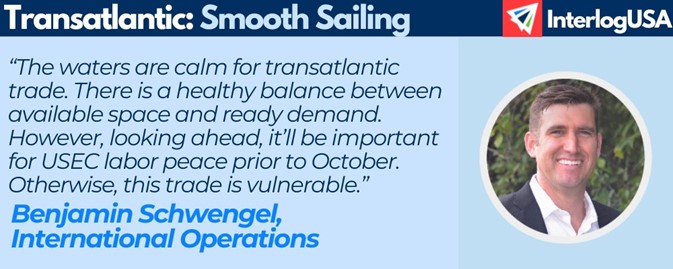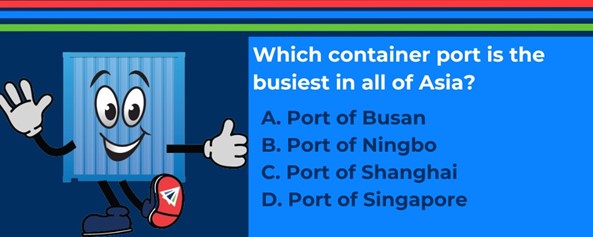Competitive Edge
July 31st, 2024
Stay Current with InterlogUSA
Latest Industry Happenings and Market Updates:
Across International Shipping: News and Developments
Port Update: Unionized longshore foremen at the Port of Vancouver are preparing a strike vote against the port’s DP World Terminal amid an ongoing dispute between their union and maritime employers. The potential labor action would include 730 foremen represented by the union. The workers’ union chapter is attempting to negotiate a separate contact with terminal operator DP World, while maritime employers assert such an exception violates their collective bargaining agreement. The results of the vote are to be announced promptly after August 9, following hearings with Canada’s labor tribunal.
Weather: Freight rail operations are returning to normal through Jasper, Alberta following last week’s wildfires which forced Canadian National to shutter rail service. The impacted section of track is apart of CN’s main line which moves freight between the ports of Vancouver and Prince Rupert.
Labor: Import data from Q2 compiled by the Journal of Commerce indicates that labor uncertainty and extended (costlier) voyages have led to an increase in cargo diversions from the East and Gulf coasts to the West Coast. The Q2 timeframe also supports a popular strategy of bringing in cargo earlier in the year to avoid these issues if they enflame in the fall.
International Longshoremen’s Association (ILA) leadership has stated that it will not seek to extend contract negotiations past their Sep. 30 deadline nor seek assistance from federal mediators to broker a deal. ILA represents unionized dockworkers at U.S. East and Gulf coast ports and is currently in negotiations for a new coastwide contract with maritime employers. If no agreement is reached by Sep. 30, the union has vowed to engage in a coastwide strike Oct. 1.
IMPORT: Asia to North America (Transpacific Eastbound)
Rates: Aside from India origins, inbound rates to all U.S. coasts have leveled this past week following several weeks of increases.
Space: Space is tight on most services. In some cases, carriers have not offered the entirety of space previously awarded within their contracts with shippers and NVOs.
Capacity: Carriers have introduced more vessels into the trade, injecting more capacity to accommodate rising demand.
Congestion: A few Asian origins are reporting congestion and extended wait times. While Singapore has become the most publicized example, certain Chinese ports, like Ningbo, are also working through backlogs.
TIPS:
- Now until at least the end of July is an ideal time to book ready cargo as rates will not increase before August. It is also uncertain how transportation costs will develop next month, lending there more reason to act as soon as possible if there’s ready cargo.
- Hold your logistics partners accountable for frequent updates regarding current market conditions, mainly continued instances of rate increases.
- Strongly consider booking shipments farther in advance as demand strengthens and space tightens.
IMPORT: Europe to North America (Transatlantic Westbound)

Looking for transatlantic shipping solutions? Contact us today!
Rates: Rates are level.
Space: Space is open.
Capacity: Reassuring demand from U.S. importers has prompted better utilization of available capacity.
TIPS:
- Book at least two weeks prior to the ready date.
- Keep an eye on East Coast labor uncertainty as a coastwide strike could occur as early as October if no contract is settled between dockworkers and maritime employers.
EXPORT: North America to Asia
Rates: Outbound rates from the West Coast have risen slightly after a freefall earlier this summer. Meanwhile, rates from the East Coast have decreased slightly. Conditions at West Coast ports are comparatively more volatile than conditions at East Coast ones.
Capacity: As seen during the pandemic, export service is vulnerable in periods when carriers set their focus on a more favorable import market, as prioritizing inbound business is more profitable. As peak import season holds steady, exporters should be cautious of how this can impact their cargo.
TIPS:
- Insufficient communication with sailing schedules can lead to higher detention and demurrage fees as well as higher trucking and storage costs. Ensure your logistics partners are not keeping you and your cargo in the dark
Freight News
FMC Mandates New Rules for Ocean Carriers on Export Policies and Loading Times
U.S. Import Volume Analysis for June 2024
New regulations were announced last Monday by the U.S. Federal Maritime Commission (FMC), where ocean carriers must document their policies for managing exports, inform shippers about any schedule or service changes, and provide sufficient loading time for ships. These measures aim to create a more equitable environment for exporters and liner operators, per the JOC.
The biggest change in the new regulations is ocean carriers will be required to submit a “documented export policy” to the FMC every year. This includes details on pricing strategies, services, routes, and equipment available for U.S. exports. This will serve as a basis for assessing whether an ocean carrier has unreasonably prevented an exporter’s container from sailing.
In June 2024, U.S. container import volumes dropped by 2.1% from May, totaling 2,297,979 TEUs. In contrast, the TEU import volume increased by 10.4% compared to June 2023, showcasing impressive year-over-year growth.
According to data from Descartes, at some of the major U.S. ports, the ports of Los Angeles (+33,253 TEUs) and Charleston (+59,933 TEUs) saw the greatest container volume increase from May. However, on the East Coast at the ports of New York/New Jersey (-59,933 TEUs) and the port of Norfolk (-28,738 TEUs) saw the greatest declines from May.
Webinar: Market Updates, Current Events
In our July webinar our team discussed:
— transpacific (west coast) and transatlantic (east coast) market conditions and updates
— any updates regarding the Panama Canal/Suez Canal?
Plus, recent current events in the industry:
— U.S. East/Gulf Coast Labor Negotiations
— Rough Weather in South Africa Impacts Vessels
— Canada Rail Union TCRC and CN/CPKC Bargaining Update
Which Container Port is the Busiest in all of Asia?
Do you know what the answer is? Reply to this email and let us know.
Johnny Cargo sure knows a lot! Other than fun facts, Johnny also can provide insight into InterlogUSA’s many service and pricing options. He is always available for a quick conversation. CLICK HERE to chat with Johnny Cargo.

Sign up for our
industry answers
Our team works to provide valuable, unique, and relevant content to assist you in finding solutions. Sign up now.

